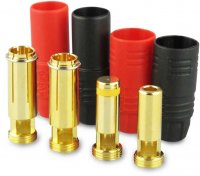...try to put your connectors together so that the positive poles are touching before you bring the negative poles together. by doing this you're forcing the electricity to run all of the way through the capacitors and through the electronics before the spark occurs so it will be greatly reduced.
For anyone who is concerned about being concerned about battery start-up sparks, i lived with it until one of my connectors de-soldered in flight as a result of spark corrosion with consequent massive resistance and heat build up. Fortunately it was a test flight and it fell out of the sky for a total of about eight inches with no harm done. It was hovering .... and then it wasn't.
After trying various anti-spark devices I now use a 'throwaway' connector cable. As all airframes are fitted with dual battery connectors they are powered up initially using the 'throwaway cable' on the first battery, then the second battery is connected, then the throwaway disconnected and the first battery connected directly.
A bit of a carry on but all the important connectors stay pristine and easy to use. I also disconnect in the reverse order, as I have noticed that sparking can also occur with a clumsy disconnect. The result is that there has been no massive battery connector change or outlay. Cheaper and simpler.
As for the 'throwaway', the extra burnt out connector pair half way down one line is replaced easily every so often. Rather than waste my normal 6mm bullets, I use whatever connectors that come supplied with stuff that I don't normally use instead of throwing them away.
And by the way, I have two 'throwaway cables'. One with the break on the positive line and one on the negative line. They both spark equally ferociously, so Bart's theory doesn't work for me.

